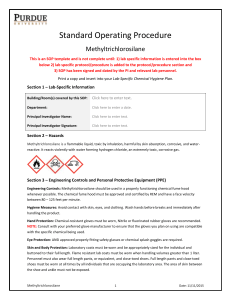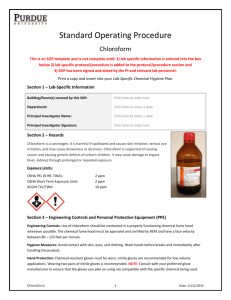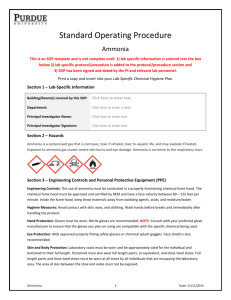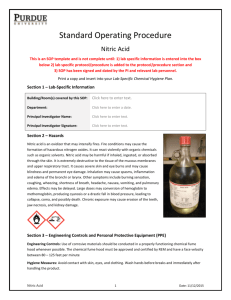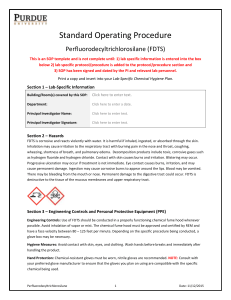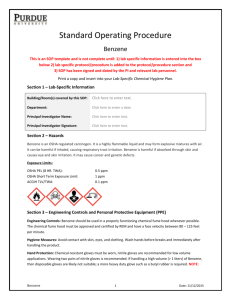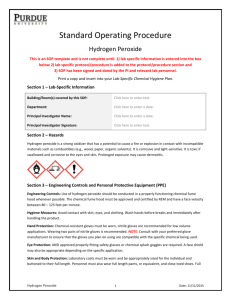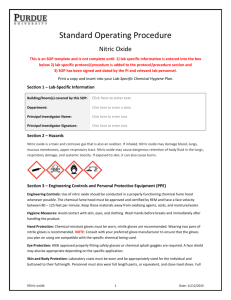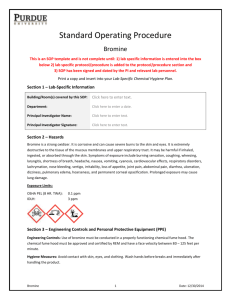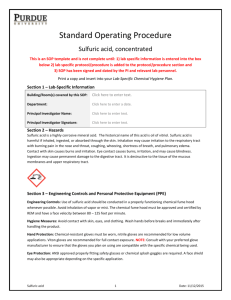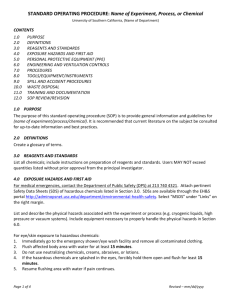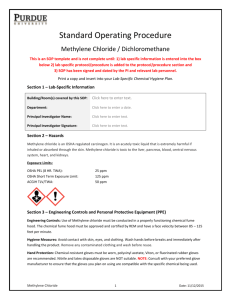Chromerge (Chromic acid solution)
advertisement
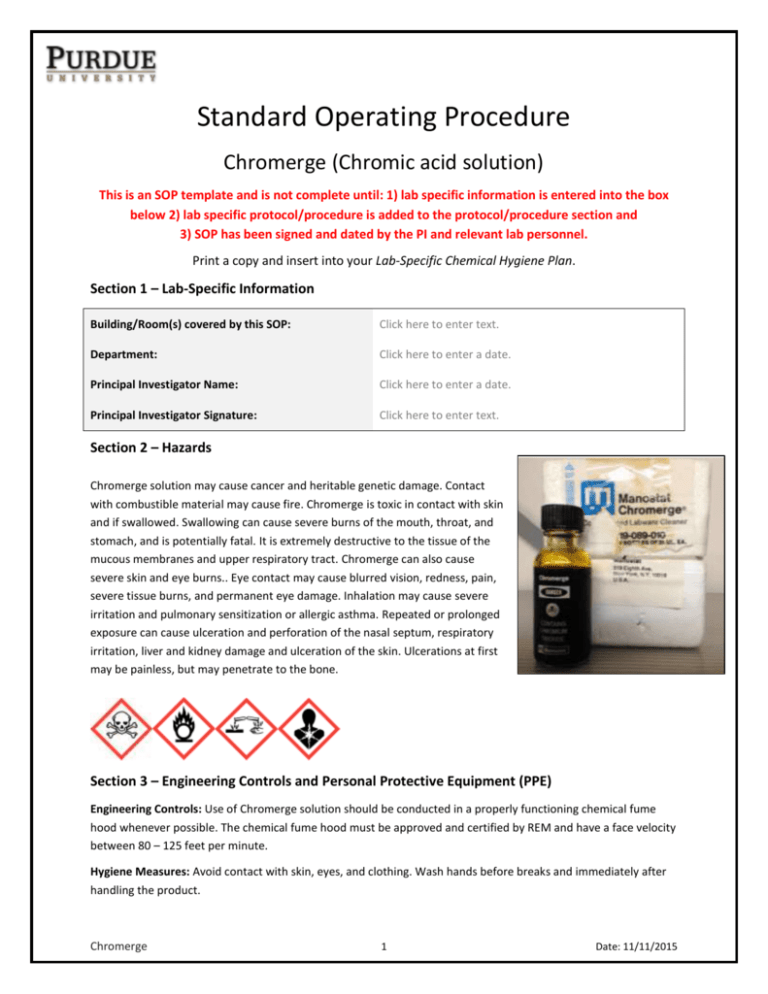
Standard Operating Procedure Chromerge (Chromic acid solution) This is an SOP template and is not complete until: 1) lab specific information is entered into the box below 2) lab specific protocol/procedure is added to the protocol/procedure section and 3) SOP has been signed and dated by the PI and relevant lab personnel. Print a copy and insert into your Lab-Specific Chemical Hygiene Plan. Section 1 – Lab-Specific Information Building/Room(s) covered by this SOP: Click here to enter text. Department: Click here to enter a date. Principal Investigator Name: Click here to enter a date. Principal Investigator Signature: Click here to enter text. Section 2 – Hazards Chromerge solution may cause cancer and heritable genetic damage. Contact with combustible material may cause fire. Chromerge is toxic in contact with skin and if swallowed. Swallowing can cause severe burns of the mouth, throat, and stomach, and is potentially fatal. It is extremely destructive to the tissue of the mucous membranes and upper respiratory tract. Chromerge can also cause severe skin and eye burns.. Eye contact may cause blurred vision, redness, pain, severe tissue burns, and permanent eye damage. Inhalation may cause severe irritation and pulmonary sensitization or allergic asthma. Repeated or prolonged exposure can cause ulceration and perforation of the nasal septum, respiratory irritation, liver and kidney damage and ulceration of the skin. Ulcerations at first may be painless, but may penetrate to the bone. Section 3 – Engineering Controls and Personal Protective Equipment (PPE) Engineering Controls: Use of Chromerge solution should be conducted in a properly functioning chemical fume hood whenever possible. The chemical fume hood must be approved and certified by REM and have a face velocity between 80 – 125 feet per minute. Hygiene Measures: Avoid contact with skin, eyes, and clothing. Wash hands before breaks and immediately after handling the product. Chromerge 1 Date: 11/11/2015 Hand Protection: Chemical-resistant gloves must be worn, nitrile gloves are recommended for low volume applications. Wearing two pairs of nitrile gloves is recommended. NOTE: Consult with your preferred glove manufacturer to ensure that the gloves you plan on using are compatible with the specific chemical being used. Eye Protection: ANSI approved properly fitting safety glasses or chemical splash goggles are required. A face shield may also be appropriate depending on the specific application. Skin and Body Protection: Laboratory coats must be worn and be appropriately sized for the individual and buttoned to their full length. Flame resistant lab coats must be worn when handling volumes greater than 1 liter. Personnel must also wear full length pants, or equivalent, and close-toed shoes. Full length pants and close-toed shoes must be worn at all times by all individuals that are occupying the laboratory area. The area of skin between the shoe and ankle must not be exposed. Respiratory Protection: If Chromerge solution is being used outside of a chemical fume hood, respiratory protection may be required. If this activity is necessary, contact REM (49-46371) so a respiratory protection analysis can be performed. Section 4 – Special Handling and Storage Requirements Avoid contact with skin, eyes, and clothing. Do not breathe vapor. Keep container tightly closed in a dry and well-ventilated area. If possible, store in corrosive/acid/lab storage cabinet within a secondary containment (Nalgene/polypropylene tray or tub). Store in original container away from direct sunlight. Avoid contact with strong bases, sulfur, sodium, phosphorus, alcohols, aluminum, alkali metals, ammonia, reducing agents, and all organic materials including organic solvents. Keep away from combustible materials, heat, sparks, and open flame. Do not store in the top most shelf of the storage cabinet. In general, do not store chemicals at or above eye level. Ensure the container is tightly closed at all times. Section 5 – Spill and Accident Procedures Immediately evacuate area and ensure others are aware of the spill. If there is an imminent threat of a fire, pull the nearest fire alarm station to evacuate the building and dial 911. If personnel have become exposed and need medical assistance, dial 911. If the spill is minor and does not pose a threat to personnel, contact REM at 49-40121 during normal business hours (Monday – Friday, 7 AM – 4 PM) for spill cleanup assistance (dial 911 if spill occurs after hours and assistance is needed). Section 6 – Waste Disposal Procedures Store hazardous waste in closed containers that are properly labeled, and in a designated area (flammable cabinet is recommended). No toxic materials are permitted to be poured down the drain. Complete a Chemical Waste Pickup Request Form to arrange for disposal by REM; detailed instructions are provided at the following link: http://www.purdue.edu/ehps/rem/hmm/chemwaste.htm. Chromerge 2 Date: 11/11/2015 Section 7 – Protocol/Procedure (Additional lab protocol may be added here) Click here to enter text. NOTE: Any deviation from this SOP requires approval from Principal Investigator. Section 8 – Documentation of Training (signature of all users is required) Prior to conducting any work with Chromerge, the Principal Investigator must ensure that all laboratory personnel receive training on the content of this SOP. I have read and understand the content of this SOP: Name Signature Date Click here to enter text. Click here to enter a date. Click here to enter text. Click here to enter a date. Click here to enter text. Click here to enter a date. Click here to enter text. Click here to enter a date. Click here to enter text. Click here to enter a date. Click here to enter text. Click here to enter a date. Click here to enter text. Click here to enter a date. Click here to enter text. Click here to enter a date. Click here to enter text. Click here to enter a date. Chromerge 3 Date: 11/11/2015
